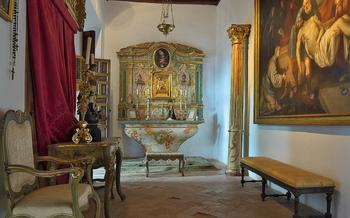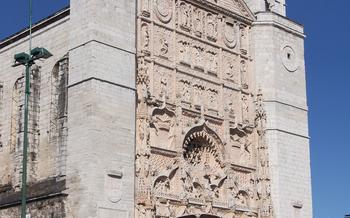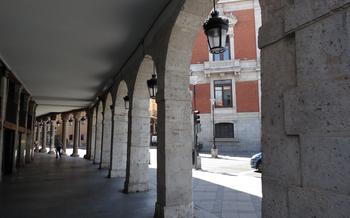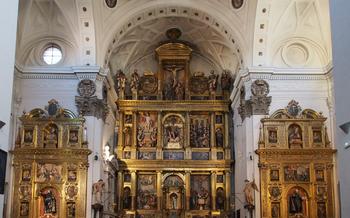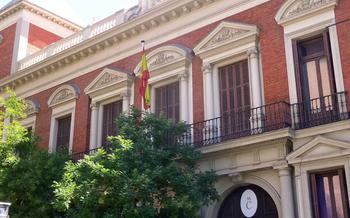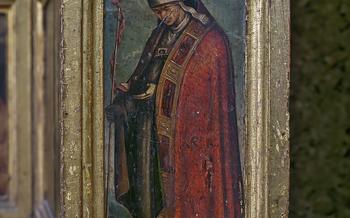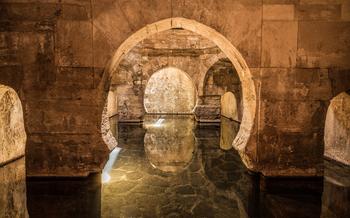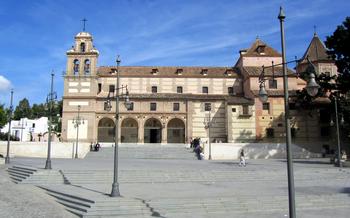
Palacio de Villena
- Significance
- Location and Accessibility
- can be traced back to the 15th century when Don Juan Pacheco, the Marquis of Villena and a powerful figure in the court of King Enrique IV, commissioned its construction. The palace was designed by the renowned architect Juan Guas, who incorporated elements of Gothic, Mudejar, and Renaissance styles, reflecting the artistic and cultural influences of the period.
- Architectural Highlights
- Collections and Exhibitions
- Gardens and Green Spaces
- Cultural Events and Performances
- Educational Programs and Workshops
- Accessibility for Visitors
- Souvenirs and Gifts
- Food and Refreshments
- Nearby Attractions and Points of Interest
- Insider Tip: Hidden Gems to Discover
Significance
The Palacio de Villena stands as a testament to Spain's rich architectural heritage and its enduring significance as a cultural landmark. Built in the 15th century, this magnificent palace has witnessed centuries of history, serving as a royal residence, a center of political power, and a cultural hub. Today, it remains a popular tourist destination, attracting visitors with its architectural beauty, historical significance, and current use as a museum and cultural center.
The palace's architectural beauty is undeniable, with its intricate Gothic and Renaissance facades, elegant towers, and a central courtyard that exudes a sense of grandeur. Its interior is equally impressive, boasting grand halls adorned with intricate ceilings, decorative elements, and a collection of art and artifacts that tell the story of Spain's past.
Location and Accessibility
The Palacio de Villena is strategically situated in the heart of Valladolid, a charming city in northwestern Spain. Its exact address is Plaza de Villena, 3, making it easily accessible on foot or by public transportation. Several bus lines stop nearby, including lines 1, 2, 3, 18, and 19, providing convenient connections from various parts of the city. For those arriving by car, limited parking is available in the vicinity, but it's advisable to use public transportation or explore the city on foot to fully immerse yourself in its vibrant atmosphere.
Insider tip: To avoid the crowds and savor a more tranquil experience, plan your visit to the Palacio de Villena during the weekdays or early in the morning. This will allow you to appreciate the palace's beauty and historical significance without the hustle and bustle of large tour groups.
can be traced back to the 15th century when Don Juan Pacheco, the Marquis of Villena and a powerful figure in the court of King Enrique IV, commissioned its construction. The palace was designed by the renowned architect Juan Guas, who incorporated elements of Gothic, Mudejar, and Renaissance** styles, reflecting the artistic and cultural influences of the period.
Over the centuries, the palace has been home to a succession of notable owners and residents. In the 16th century, it passed into the hands of the Duques de Lerma, who made significant additions and renovations to the palace, including the construction of the Torre del Homenaje (Homage Tower) and the Patio de Honor (Courtyard of Honor). In the 18th century, the palace was acquired by the Marquis of Campo Alange, who further embellished the interior with elaborate decorations and furnishings.
Throughout its history, the Palacio de Villena has been the stage for many important historical events. In the 15th century, it served as a meeting place for the Catholic Monarchs, King Ferdinand, and Queen Isabella, who planned their campaigns against the Nasrid Kingdom of Granada within its walls. In the 19th century, the palace was briefly used as a military hospital during the Peninsular War.
Anecdote: A tale of love and intrigue within the palace walls
Legend has it that in the 16th century, a secret love affair blossomed between a young noblewoman named Doña Juana and a handsome commoner named Rodrigo. Their clandestine meetings took place within the hidden passageways of the palace, away from the watchful eyes of her family. Their love story, filled with passion and intrigue, became a whispered tale among the palace servants and is still remembered today as a testament to the enduring power of love.
Architectural Highlights
The Palacio de Villena stands as a testament to the architectural prowess of the Renaissance era. Its exterior façade, crafted from golden-hued sandstone, exudes an aura of grandeur. The intricate carvings adorning the entrance, depicting scenes from mythology and nature, hint at the artistic treasures within. Flanking the main entrance, two elegant towers, each crowned by a delicate spire, add a touch of verticality to the building's silhouette.
Stepping inside the palace, visitors are greeted by a courtyard that serves as a tranquil oasis amidst the bustling city. Surrounded by graceful arcades supported by slender columns, the courtyard invites visitors to linger and soak in the serene atmosphere. The intricate tilework underfoot, featuring geometric patterns and vibrant colors, adds a touch of whimsy to the space.
The palace's interior boasts a series of grand halls, each adorned with intricate ceilings and decorative elements. The Salón de Embajadores, or Hall of Ambassadors, is particularly noteworthy for its coffered ceiling, featuring intricate carvings depicting scenes from history and mythology. The walls of the hall are adorned with tapestries and paintings, adding to the room's opulent ambiance.
The Palacio de Villena showcases a harmonious blend of architectural styles, drawing inspiration from both Gothic and Renaissance traditions. The pointed arches and ribbed vaults of the Gothic era are juxtaposed with the classical elements of the Renaissance, such as the symmetrical façade and the use of pilasters and pediments. This eclectic mix of styles creates a visually captivating and unique architectural masterpiece.
Anecdote: A Hidden Architectural Detail Often Missed by Visitors
One often-overlooked architectural detail of the Palacio de Villena is a series of small, intricately carved gargoyles hidden among the eaves of the roof. These whimsical figures, each with its own unique expression and posture, seem to come alive as the shadows lengthen, casting eerie silhouettes on the palace walls. Visitors who take the time to seek out these hidden treasures will be rewarded with a glimpse into the playful side of the palace's design.
Collections and Exhibitions
The Palacio de Villena houses an impressive permanent collection that showcases the rich history and artistic heritage of the region. Visitors can admire a diverse range of artifacts, including paintings, sculptures, tapestries, furniture, and decorative objects. These items provide a glimpse into the lives of the palace's former occupants and the cultural trends that shaped their era.
In addition to the permanent collection, the palace also hosts a variety of temporary exhibitions throughout the year. These exhibits often focus on specific themes or artists and feature works from both local and international collections. Temporary exhibitions offer visitors an opportunity to explore new perspectives and gain insights into contemporary artistic practices.
Special events and workshops are also held regularly at the palace. These events include lectures, concerts, film screenings, and educational workshops. They provide visitors with an opportunity to engage with the palace's history, architecture, and collections in a more interactive and immersive way.
Insider tip: Guided tours of the palace are available and offer an in-depth exploration of the collections and exhibitions. These tours are led by knowledgeable guides who can provide insights into the history, significance, and artistic value of the works on display.
Gardens and Green Spaces
The Palacio de Villena boasts enchanting gardens that serve as an oasis of tranquility amidst the bustling city. Designed in the Renaissance style, the gardens feature a symmetrical layout, with manicured lawns, vibrant flowerbeds, and towering trees providing a picturesque backdrop. Notable features include a central fountain, ornate gazebos, and sculptures that add to the garden's charm.
Historically, the gardens were used for leisure and entertainment by the palace's residents. Today, they remain a popular spot for visitors to relax and soak in the peaceful atmosphere. The gardens also serve as a venue for outdoor events, such as concerts, exhibitions, and weddings.
If you're a nature enthusiast, be sure to visit the gardens during the spring or summer, when they are in full bloom. The vibrant colors and fragrant scents create a magical ambiance that will leave you feeling refreshed and rejuvenated.
Cultural Events and Performances
The Palacio de Villena is not just a historical landmark but also a vibrant cultural hub, hosting a variety of events and performances throughout the year. Regular concerts, theater productions, and art exhibitions showcase the talents of local and international artists.
The palace comes alive during special festivals and celebrations, such as the Valladolid International Film Festival, where movie enthusiasts gather to watch screenings, attend workshops, and meet filmmakers. Historical reenactments and immersive experiences transport visitors back in time, allowing them to witness the grandeur and pageantry of the palace's past.
Anecdote: A Memorable Cultural Event or Performance Witnessed at the Palace
During the annual Valladolid Jazz Festival, I had the privilege of attending a mesmerizing concert in the grand hall of the Palacio de Villena. The acoustics were impeccable, and the atmosphere was electric as the renowned jazz ensemble filled the room with their soulful melodies. It was a truly unforgettable evening, and the memory of that performance still lingers in my mind.
Educational Programs and Workshops
The Palacio de Villena is not just a historical landmark; it is also a vibrant center for education and cultural enrichment. The palace offers a range of programs and workshops tailored to visitors of all ages, providing an immersive and interactive experience.
-
School groups can embark on guided tours that bring history to life, with engaging storytelling and hands-on activities.
-
Art enthusiasts can participate in workshops focused on various art forms, from painting and drawing to sculpture and ceramics, using the palace's rich artistic heritage as inspiration.
-
History buffs can delve deeper into the palace's past through lectures, seminars, and reenactments, gaining insights into the lives of its former inhabitants and the events that shaped its history.
-
Families can enjoy special events and summer camps designed to entertain and educate children, with activities such as storytelling, crafts, and interactive games.
Insider tip: Advance booking is recommended for popular workshops, especially during school holidays, to secure a spot and avoid disappointment.
Accessibility for Visitors
The Palacio de Villena is committed to providing an accessible and welcoming experience for all visitors. The palace features a range of accessibility features to ensure that everyone can enjoy its treasures.
Wheelchair ramps and elevators are available throughout the palace, making it easy for visitors with mobility challenges to explore all areas. Visitors can request a wheelchair or other assistance upon arrival. Guided tours tailored for visitors with specific needs are also available.
Audio guides and information are provided in multiple languages, catering to visitors from diverse backgrounds. For those who prefer a more immersive experience, sign language interpreters can be arranged upon prior request.
To ensure a smooth and enjoyable visit, we recommend that visitors with disabilities contact the palace in advance to discuss any specific requirements or preferences. The staff is dedicated to providing the necessary support and accommodations to create a memorable and inclusive experience for all visitors.
Souvenirs and Gifts
The Palacio de Villena houses an alluring gift shop that beckons visitors to carry a piece of history home. Immerse yourself in the palace's rich legacy through a diverse collection of souvenirs and gifts. From intricate replicas of the palace's architectural elements to books chronicling its fascinating past, there's something for every taste.
But the gift shop's allure doesn't end there. It's a treasure trove of one-of-a-kind items inspired by the palace's grandeur. Discover hand-crafted jewelry reminiscent of the intricate carvings that adorn the palace's walls, or elegant scarves adorned with motifs echoing the tapestries that once graced its halls.
For those seeking a deeper connection to the palace's history, the gift shop offers a selection of books and educational materials. Delve into the lives of the notable figures who once resided within these walls or explore the architectural intricacies that make the palace a masterpiece.
Insider tip: Keep an eye out for limited-edition souvenirs and collectibles that capture the essence of the Palacio de Villena's unique charm. These exclusive items make for cherished mementos or thoughtful gifts for loved ones back home.
Food and Refreshments
Culinary Delights in a Historic Setting
Visitors to the Palacio de Villena can enjoy a delightful culinary experience within the palace grounds. The on-site café, "La Terraza del Palacio," offers a range of tempting options to satisfy every palate. From light snacks and refreshing beverages to hearty meals inspired by traditional Spanish cuisine, the café provides a delightful culinary journey in a historic setting.
For those who prefer a more leisurely dining experience, the palace gardens offer a picturesque backdrop for a picnic. Visitors can spread out their blankets and savor the flavors of a homemade feast surrounded by the beauty of the palace's surroundings.
Venturing outside the palace walls, Valladolid's culinary scene offers a diverse range of dining options. From traditional Spanish tapas bars to Michelin-starred restaurants, visitors can explore a variety of cuisines and flavors that reflect the city's rich cultural heritage.
Anecdote: A Delightful Culinary Experience
During a recent visit to the Palacio de Villena, I had the pleasure of dining at "La Terraza del Palacio." The atmosphere was simply enchanting, with the historic architecture providing a backdrop to my culinary adventure. I opted for the "Menú del Día," a daily special that showcased the flavors of traditional Spanish cuisine. The dishes were beautifully presented, and each bite was a delight. The attentive service and the warm ambiance made the dining experience truly memorable.
Nearby Attractions and Points of Interest
Valladolid, the vibrant capital of the Castilla y León region, is home to a wealth of historical sites, cultural attractions, and entertainment options. The city's rich heritage is reflected in its many museums, including the Museo Nacional de Escultura, which houses an impressive collection of religious sculptures from the Middle Ages to the Baroque period. For a glimpse into the city's past, visit the Museo de Valladolid, where you can explore artifacts and exhibits that tell the story of Valladolid's evolution from a small medieval town to a thriving modern city.
Art enthusiasts will delight in the Museo de Arte Contemporáneo Español, which showcases a diverse range of contemporary Spanish art, including paintings, sculptures, and installations. Valladolid's cultural offerings extend beyond museums, with several theaters and concert halls hosting a variety of performances, from classical music concerts to contemporary dance productions. The city's vibrant nightlife scene offers a range of bars, clubs, and restaurants, ensuring that there is something to suit every taste.
Shopping enthusiasts will find plenty to keep them entertained in Valladolid's many shopping areas, from traditional markets to modern shopping malls. The city's historic center is home to a variety of boutiques and specialty shops, where you can find everything from handmade crafts to designer clothing. For a wider selection of dining options, head to one of the many restaurants and cafes located throughout the city, offering a diverse range of cuisines from traditional Spanish dishes to international fare.
Insider Tip: To fully immerse yourself in the local culture, plan to spend at least a day or two exploring Valladolid's many attractions. The city's compact size makes it easy to get around on foot, allowing you to discover hidden gems and experience the city's unique atmosphere.
Insider Tip: Hidden Gems to Discover
Beyond the main attractions and well-known features of the Palacio de Villena, there are hidden gems waiting to be discovered by curious explorers. One such secret is a hidden passageway leading to a secluded garden, accessible through an unassuming door in the palace's north wing. This enchanting garden, with its fragrant flowers, murmuring fountains, and ancient trees, offers a tranquil retreat from the bustling palace corridors.
Another hidden gem is a small room tucked away on the palace's top floor. This room, once used as a private study by a former royal resident, boasts stunning panoramic views of Valladolid's cityscape and the surrounding countryside. Visitors who venture up to this hidden chamber are rewarded with a breathtaking perspective of the city, making it a perfect spot for contemplation and inspiration.
For those with a keen eye for detail, the palace's intricate carvings and decorative elements reveal hidden stories and symbols. Look closely at the ornate ceiling frescoes and you might spot a mischievous cherub or a hidden animal figure. These subtle details add depth and intrigue to the palace's visual tapestry, rewarding attentive visitors with a deeper understanding of its rich history and artistry.

